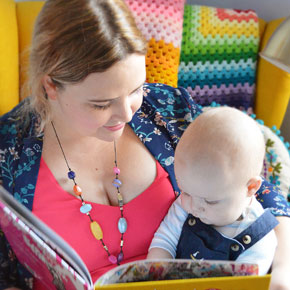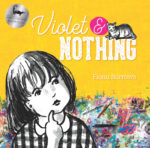Mums, bubs and creativity: picture book author Fiona Burrows on inspiring a love of reading in children

Fremantle Press author and new mum Fiona Burrows explains how she came up with the idea of her new picture book Violet and Nothing, and why it’s never too early to encourage children to be creative.
How did you create the concept for the story? What inspired you?
The character and concept of the story came out of the blue while I was away on a writing retreat, but Violet is very similar to me as a child. I was always asking big questions and being endlessly curious about everything. I love how philosophical and imaginative children are, and I really wanted to celebrate that in this book.
How long did Violet and Nothing take to create?
The story itself only took a day or so to write, and actually didn’t change too much from the first draft to published version. But the publishing process and the illustrations took a lot longer – maybe two years from start to finish. There was a lot of planning and storyboarding, and feedback along the way.
What medium and art style did you use?
For this book, I wanted to have a contrast between colour and black-and-white elements. I used a mixture of pencil, ink, watercolour, gouache, digital and even a little collage. When I first started I wasn’t sure how I was going to be able to represent the ideas in the story (how do you draw ‘nothing’?!), but contrasting colour with monochrome worked really well and was so much fun.
Have you always wanted to be a writer/illustrator?
Yes, ever since I was young! I loved writing and drawing as a child, and I was constantly making picture books for my younger siblings. When I was in primary school I won a prize in the CBCA Make Your Own Storybook competition, and I think that was one of the earliest moments of thinking that making books might be a career.
Is there one question that you’ve always wanted to ask the world, like Violet does, and have you found the answer to it yet?
When I was young, I was very interested in the idea of reality and perception, and whether what you see is the same as what I see. I did my PhD on a similar sort of thing – synaesthesia, or ‘mixed’ sensory perceptions, and poetry. I still haven’t found an answer, but it has given me lots of creative inspiration along the way, which is just as important.
How do you juggle being a mum and being creative?
I struggled with terrible morning sickness while finishing the illustrations for Violet and Nothing, so that was tough. It’s also been hard trying to navigate the newborn stage and adjust to motherhood while juggling different projects. But having my son has been immensely rewarding in a creative sense, and as he grows and learns I find myself seeing the world in an entirely new way through his eyes. It’s true that motherhood changes everything about you, including your creative life.
What advice would you give to new mums who still want to pursue what they love?
Do it! Whatever inspires or drives your passion is worth following. I used to think that it would be impossible to have a family and pursue a writing and illustrating career, but then I had a baby and made four picture books in one year. It’s not easy: you need to find ways to fit it into your life, and that can be a challenge, but it’s worth it. Accept all offers of help.
Is it ever too early to encourage children to be creative?
Certainly not! Allowing children to explore their interests and curiosity, to express themselves creatively and use their imaginations is just as essential as teaching them to read and write. There’s a tendency to focus on more structured activities to encourage learning, but unstructured play can actually be the most beneficial thing for little minds. In fact, it’s even useful for adults to approach a creative project without any defined plans or preconceptions, and see what happens when you just ‘play’. Sometimes you get the best ideas that way.
How can new parents encourage creativity in their little ones?
Read to them, draw with them, play make-believe with them. Make up a song together. Go to the art gallery and talk about the artworks. Ask them questions, and genuinely engage with their answers – they’ll often surprise you. It’s important to never underestimate them, and to not police their interests or topics too much simply because you think something might be too advanced or difficult for them; children have an amazing capacity to entertain complex ideas and concepts.
How important is reading for young children?
Absolutely vital. There’s no better gift you can give your child than reading to them widely, frequently and from as young an age as possible. Books, words and pictures teach children so much, but they also encourage them to see things from different perspectives and imagine themselves in other people’s shoes, which are valuable qualities to develop in a world where empathy and open-mindedness can sometimes be lacking. Reading together is such a lovely way to bond with your child too, and to foster a love and enjoyment of books that they will carry their whole lives.
Violet and Nothing by Fiona Burrows is available from all good bookstores and online at www.fremantlepress.com.au.



